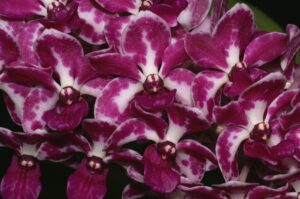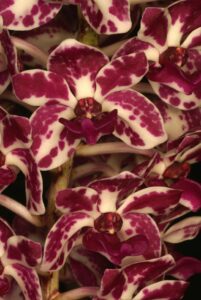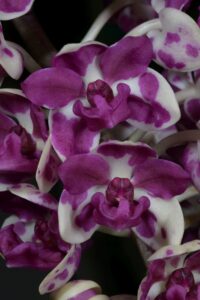The following article was written for the Orchid Species Bulletin published by the Orchid Species Society, which is based in Brisbane, Queensland in August 2000, and updated in August 2021.
Bear in mind that any cultivation notes refer to the subtropical conditions of Southern Queensland, Australia.
Rhynchostylis gigantea (Lindl.) Ridl. f. illustris Rchb.f. is the brightly-marked form of the species, which was first described by John Lindley, as Saccolabium giganteum in Genera and Species of Orchidaceous Plants, in 1833. The specific epithet comes from the Greek gigant (giant, very large), and the suffix –eus (belonging to), referring to the gigantic size of the plant. Henry Ridley transferred it to Rhynchostylis in the Journal of the Linnean Society in 1896.

Rhynchostylis gigantea f. illustris
Rhy. gigantea is a very large, epiphytic, monopodial plant, which produces stout, upright stems that may be up to 15-20 cm or more long, and 2 cm in diameter. Older plants will eventually produce growths from near the base, forming a cluster of several stems. Along the stems are two-ranked, alternating leaves, which are 15-35 cm long, and 4-7.5 cm broad. The bright green leaves are very thick, linear, channelled, and are longitudinally striped with pale green veins on both sides. Stout, fleshy roots, which are 12-18 mm in diameter, emerge from near the base, and later on, from further up the stem.

Rhynchostylis gigantea f. illustris
Several (2-4) pendulous inflorescences, which are 20-35 cm long, are produced from nodes in the axils of the leaves. The inflorescences of Rhy. gigantea carry many flowers (up to 50), in a dense, cylindrical raceme. The strongly day-fragrant, fleshy flowers are 2.5-3 cm across. Variable in colour, the flowers have white sepals and petals, with a few violet to purple spots particularly near the base, but sometimes all over. The lip is white, with a purplish midlobe. There are 2 sparsely pubescent ridges, which descend into the backward-pointing spur, at the base of the lip. Its column is green, with purplish markings.
Rhy. gigantea is quite variable in colour, with pure white, and pure rose-purple to amethyst-purple forms known. Line-breeding of these rare colour forms, has meant that they are now more readily available in cultivation. Some of the colour forms, which have been described include:

Rhynchostylis gigantea f. illustris ‘Cartoon’
Rhy. gigantea is distributed in Myanmar, Laos, Vietnam, Thailand, Hainan and southward to the islands of the China Sea, Peninsular Malaysia, and Borneo. The lowland habitat is between sea level, up to 700 m elevation. In Vietnam, it grows on trees along the edge of the forest, sometimes high in the trees. During the dry season in Myanmar, temperatures reach 45 oC in the shade. Often the plants are exposed to high light in the deciduous trees, so that the leaves are scorched by the sunlight.
Due to the thick roots, which hate to be confined, Rhy. gigantea is best cultivated in a basket, or a well-drained pot, using a coarse medium. For the southeast Queensland area, shading of 70% seems ideal, together with good air circulation. Rhy. gigantea can be watered and fertilised frequently during the warmer months, while the root tips are green. Water frequency can be tapered off, during late autumn. The plants need a slightly drier rest, to help initiate the inflorescences. I recommend a covered roof or overhead protection during winter, to control the water, and a minimum of 18 ⁰C.
References:
Bechtel, H., Cribb, P. & E. Launert. (1992) The Manual of Cultivated Orchid Species. 3rd ed. Blandford Press, London.
Holttum, R.E. (1964) Orchids of Malaya. 3rd ed. Government Printing Office, Singapore.
Linden, J., Linden, L., Rodigas, E. & R.A. Rolfe. (1885-1888) Lindenia – Vol. 1. 1993 reprint. Naturalia Publications, Turriers, France.
Linden, J., Linden, L., Rodigas, E. & R.A. Rolfe. (1894-1898) Lindenia – Vol. 4. 1993 reprint. Naturalia Publications, Turriers, France.
Seidenfaden, G. (1988) Orchid Genera in Thailand XIV – Fifty-nine Vandoid Genera. Opera Botanica, Copenhagen.
Seidenfaden, G. (1992) The Orchids of Indochina. Opera Botanica, Copenhagen.
Seidenfaden, G. & J.J. Wood. (1992) The Orchids of Peninsular Malaysia and Singapore. Olsen & Olsen, Fredensborg, Denmark.
Stearn, W.T. (1983) Botanical Latin. 3rd ed. David & Charles Inc. Vermont, USA.
Stewart, J. & M. Griffiths. (1995) Manual of Orchids. Timber Press, Portland, Oregon.
Vaddhanaphuti, N. (1997) A Field Guide to the Wild Orchids of Thailand. Silkworm Books, Chiang Mai.
Veitch, J. & Sons. (1887-94) A Manual of Orchidaceous Plants. H.M. Pollett & Co., London.
